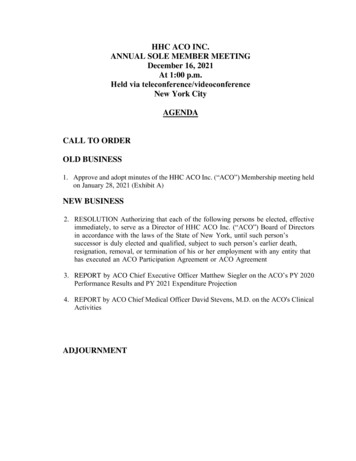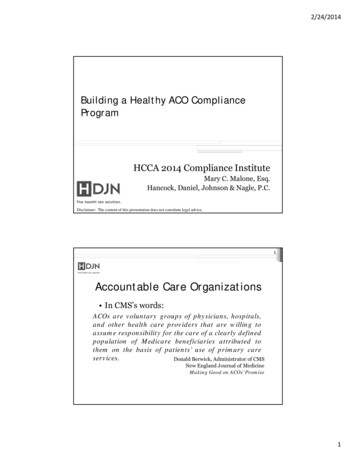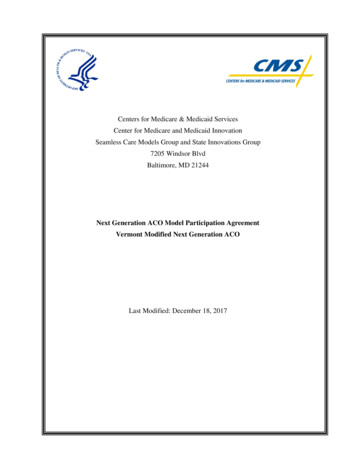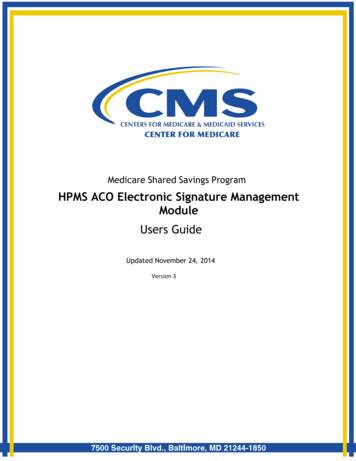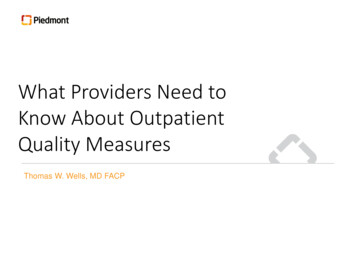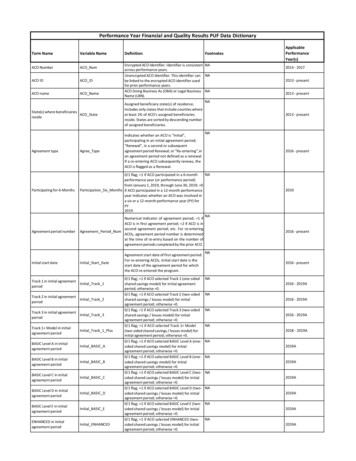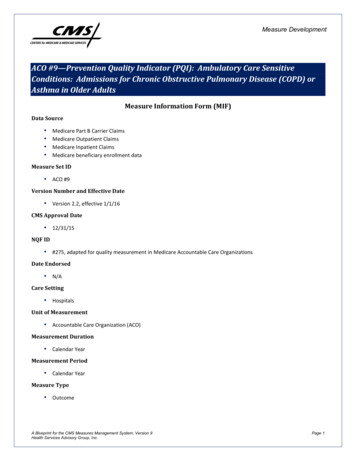
Transcription
Measure DevelopmentACO #9—Prevention Quality Indicator (PQI): Ambulatory Care SensitiveConditions: Admissions for Chronic Obstructive Pulmonary Disease (COPD) orAsthma in Older AdultsMeasure Information Form (MIF)Data Source Medicare Part B Carrier ClaimsMedicare Outpatient ClaimsMedicare Inpatient ClaimsMedicare beneficiary enrollment dataMeasure Set ID ACO #9Version Number and Effective Date Version 2.2, effective 1/1/16CMS Approval Date 12/31/15NQF ID #275, adapted for quality measurement in Medicare Accountable Care OrganizationsDate Endorsed N/ACare Setting HospitalsUnit of Measurement Accountable Care Organization (ACO)Measurement Duration Calendar YearMeasurement Period Calendar YearMeasure Type OutcomeA Blueprint for the CMS Measures Management System, Version 9Health Services Advisory Group, Inc.Page 1
Measure DevelopmentMeasure Scoring Prevention quality indicator (PQI) score, that is a ratio of observed admissions to expected admissions for ChronicObstructive Pulmonary Disease (COPD) or Asthma. In addition to the observed to expected ratio, we will alsoprovide ACOs with a score that reflects the risk adjusted percentage. The risk adjusted percentage is the observedto expected ratio multiplied by the overall admission percentage [(total admissions/total person years)*100]across all ACOs. ACOs can compare their performance with the 2016 and 2017 benchmarks available vicePayment/sharedsavingsprogram/Quality Measures Standards.html.Payer Source Medicare Fee-for-ServiceImprovement Notation Lower PQI scores are betterMeasure StewardAgency for Healthcare Research and Quality (AHRQ) with adaptations by Centers for Medicare and Medicaid Services (CMS)(co-stewards).Copyright / Disclaimer This Medicare ACO PQI COPD/Asthma quality measure is adapted from the general population PQI quality measurefor COPD/Asthma that is developed by AHRQ (AHRQ, 2013).Measure Description All discharges with an ICD-10 principal diagnosis code for COPD or Asthma in adults ages 40 years and older, forACO assigned (Shared Savings Program) or aligned (Pioneer) Medicare beneficiaries with COPD or Asthma, withrisk-adjusted comparison of observed discharges to expected discharges for each ACO.RationaleHospital admissions for COPD or asthma are a Prevention Quality Indicator of interest to comprehensive health caredelivery systems including ACOs. COPD or Asthma can often be controlled in an outpatient setting. Evidence suggests thatthese hospital admissions could have been avoided through high quality outpatient care, or the condition would have beenless severe if treated early and appropriately. Proper outpatient treatment and adherence to care may reduce the rate ofoccurrence for this event, and thus of hospital admissions.Clinical Recommendation StatementBindman et al. (1995) reported that self-reported access to care explained 27 percent of the variation in COPDhospitalization rates at the ZIP code cluster level. Millman (1993) found that low-income ZIP codes had 5.8 times moreCOPD hospitalizations per capita than high-income ZIP codes. Physician adherence to practice guidelines and patientcompliance also influence the effectiveness of therapy. Practice guidelines for COPD have been developed and publishedover the last decade (Hackner, 1999). With appropriate outpatient treatment and compliance, hospitalizations for theexacerbations of COPD and decline in lung function should be minimized.Based on empirical results, areas with high rates of COPD admissions also tend to have high rates of admissions for otherAmbulatory Care Sensitive Conditions. The signal ratio (i.e., the proportion of the total variation across areas that is trulyA Blueprint for the CMS Measures Management System, Version 9Health Services Advisory Group, Inc.Page 2
Measure Developmentrelated to systematic differences in area performance rather than random variation) is very high, at 93.4 percent, indicatingthat the differences in age-sex adjusted rates likely represent true differences across areas (AHRQ, 2007).Risk adjustment for age and sex exerts strongest influence in areas with highest admission rates. As a PQI, admissions forchronic obstructive pulmonary disease are not a measure of hospital quality, but rather one measure of the quality ofambulatory care.ReferencesAHRQ. Guide to Prevention Quality Indicators. Rockville, Maryland: U.S. Agency for Healthcare Research and Quality, 2007.Bindman AB, Grumbach K, Osmond D, et al. Preventable hospitalizations and access to health care. JAMA1995;274(4):305–11.Hackner D, Tu G, Weingarten S, et al. Guidelines in pulmonary medicine: a 25-year profile. Chest 1999; 116(4):1046–62.Millman M, editor. Committee on Monitoring Access to Personal Health Care Services. Washington, DC: National AcademyPress; 1993.2015 Release Notes / Summary of Changes There have been no substantial changes made to the measure specifications. The specifications reflect the mostrecent version (version 5, October 2015) of the technical specifications posted on the AHRQ website for PQI #8.Technical Specifications Target Population: ACO assigned or aligned Medicare beneficiariesDenominator Denominator StatementAssigned/Aligned Medicare FFS Beneficiaries aged 40 years and older that have a diagnosis of COPD or Asthma (asidentified in table below). Denominator DetailsThe ICD-10 codes used to identify Medicare beneficiaries with COPD or Asthma for this Medicare ACO PQI qualitymeasure are as .2J43.8J43.9J44.0J44.1J44.9DescriptionSimple chronic bronchitisMucopurulent chronic bronchitisMixed simple and mucopurulent chronic bronchitisUnspecified chronic bronchitisUnilateral pulmonary emphysema [MacLeod's syndrome]Panlobular emphysemaCentrilobular emphysemaOther emphysemaEmphysema, unspecifiedChronic obstructive pulmonary disease with acute lower respiratory infectionChronic obstructive pulmonary disease with (acute) exacerbationChronic obstructive pulmonary disease, unspecifiedA Blueprint for the CMS Measures Management System, Version 9Health Services Advisory Group, Inc.Page 3
Measure 5.990J45.991J45.998DescriptionBronchiectasis with acute lower respiratory infectionBronchiectasis with (acute) exacerbationBronchiectasis, uncomplicatedMild intermittent asthma with (acute) exacerbationMild intermittent asthma with status asthmaticusMild persistent asthma with (acute) exacerbationMild persistent asthma with status asthmaticusModerate persistent asthma with (acute) exacerbationModerate persistent asthma with status asthmaticusSevere persistent asthma with (acute) exacerbationSevere persistent asthma with status asthmaticusUnspecified asthma with (acute) exacerbationUnspecified asthma with status asthmaticusExercise induced bronchospasmCough variant asthmaOther asthmaThese ICD-10 codes for COPD or Asthma can be found in any diagnosis position for any Medicare Outpatientclaims, Inpatient claims, or Part B Carrier claims for the ACO’s assigned or aligned beneficiary in the performanceyear for the beneficiary to be included in the denominator.The Medicare ACO PQI quality measure denominator specifications are adapted from the AHRQ PQI specificationswith adjustments to the reference population to focus on Medicare beneficiaries since they are likely to be olderand more disabled than the general population. Additionally, ACOs may have more and varying proportions ofpatients with the chronic conditions targeted by the PQI quality measures (COPD or Asthma for this ACO PQI). As aresult, the changes made to adapt the AHRQ PQIs to the Medicare population for the Medicare ACO PQIs includethe following:1.Change the PQI denominator to include only Medicare beneficiaries assigned or aligned to a Medicare ACO,instead of the general population in a geographic area (as currently specified for AHRQ PQIs), and allow partyear Medicare beneficiaries to be included in the denominator.2.Change the PQI denominators to include only those beneficiaries who were diagnosed with the conditionunder consideration (COPD/Asthma) instead of patients of any disease status (as currently specified for AHRQPQIs).3.Exclude beneficiaries with a diagnosis of ESRD from the denominator populations for. ESRD patients aresignificantly more prone to hospitalization, are severely ill, and are a much larger proportion of Medicarebeneficiaries than they are in the general population. As a result, the PQI measures may not be goodmeasures of quality of care in treatment of Medicare beneficiaries with COPD or Asthma who also have ESRD. Denominator Exceptions and Exclusions1.Beneficiaries with a diagnosis of ESRD2.Beneficiaries not eligible for both Medicare Part A and Part B3.Beneficiaries with missing data for gender, age, or principal diagnosisA Blueprint for the CMS Measures Management System, Version 9Health Services Advisory Group, Inc.Page 4
Measure Development Denominator Exceptions and Exclusions DetailsTo identify beneficiaries for the ESRD exclusion the MS CD variable (CWF Beneficiary Medicare Status Code) isused. Excluded beneficiaries including those with MS CD values equal to 11 (aged with ESRD), 21 (disabled withESRD), or 31 (ESRD only).Numerator Numerator StatementObserved discharges from an acute care hospital or critical access hospital with a principal diagnosis of ChronicObstructive Pulmonary Disease or Asthma, for Medicare beneficiaries in the denominator population for thismeasure. Numerator DetailsThe ICD-10 codes used to identify hospital discharges with a principal diagnosis of COPD or Asthma for thisMedicare ACO PQI quality measure are as follows:1.An ICD-10 principal diagnosis code that indicates COPD (listed in Appendix A)OR2.An ICD-10 principal diagnosis code that indicates acute bronchitis (listed in Appendix A) AND an ICD-10secondary diagnosis code that indicates COPD (Listed in Appendix A)OR3.An ICD-10 principal diagnosis code that indicates asthma (Listed in Appendix A)These ICD-10 codes for COPD or Asthma can be found for any Medicare Inpatient claims for the ACO’s assigned oraligned beneficiary in the performance year for that discharge to be included in the numerator. The sum of all ofthese discharges is calculated for the performance year for all of the assigned or aligned beneficiaries for each ACOto calculate the numerator. Numerator Exceptions and Exclusions1.Transfers to a hospital, Skilled Nursing Facility (SNF) or Intermediate Care Facility (ICF), or another health carefacility are excluded from the numerator2.Discharges are excluded from the numerator if the admission is associated with a diagnosis of Cystic fibrosis oranomalies of the respiratory system Numerator Exceptions and Exclusions Details1.The AHRQ PQI SAS software excludes admissions that are transfers to a hospital, skilled nursing facility orIntermediate Care Facility, or another healthcare facility, identifying these transfers using HCUP variables SIDASOURCE and POINTOFORIGINUB04 codes. The Medicare claims data available from the IDR does not includethese codes. As a result, the Medicare ACO PQIs use the Medicare claims variable “Source of Admission(SRC ADMS)” to identify transfers. For the Medicare ACO PQIs patients were excluded with an SCR ADMSvalue of 4 (transfer from hospital), 5 (transfer from skilled nursing facility), or 6 (transfer from another healthcare facility). However, previous work with the SCR ADMS variable has found that it is sometimes unreliable.As a result, to better ensure that all transfers were excluded the Medicare ACO PQI software excludesbeneficiaries with two Part A Inpatient claims admissions on the same day at two different facilities.A Blueprint for the CMS Measures Management System, Version 9Health Services Advisory Group, Inc.Page 5
Measure Development2.Discharge is excluded from the numerator if the admission is associated with a diagnosis of Cystic fibrosis oranomalies of the respiratory system, as indicated by any of the following ICD-10 diagnosis ionCystic fibrosis with pulmonary manifestationsMeconium ileus in cystic fibrosisCystic fibrosis with other intestinal manifestationsCystic fibrosis with other manifestationsCystic fibrosis, unspecifiedSurfactant mutations of the lungNeuroendocrine cell hyperplasia of infancyPulmonary interstitial glycogenosisAlveolar capillary dysplasia with vein misalignmentOther interstitial lung diseases of childhoodWilson-Mikity syndromeBronchopulmonary dysplasia originating in the perinatal periodOther chronic respiratory diseases originating in the perinatal periodUnspecified chronic respiratory disease originating in the perinatal periodOther congenital malformations of aortaCongenital subglottic stenosisLaryngeal hypoplasiaLaryngoceleCongenital laryngomalaciaOther congenital malformations of larynxCongenital malformation of larynx, unspecifiedCongenital tracheomalaciaOther congenital malformations of tracheaCongenital bronchomalaciaCongenital stenosis of bronchusOther congenital malformations of bronchusCongenital cystic lungAccessory lobe of lungSequestration of lungAgenesis of lungCongenital bronchiectasisEctopic tissue in lungCongenital hypoplasia and dysplasia of lungOther congenital malformations of lungCongenital malformation of lung, unspecifiedAnomaly of pleuraCongenital cyst of mediastinumOther specified congenital malformations of respiratory systemCongenital malformation of respiratory system, unspecifiedAtresia of esophagus without fistulaAtresia of esophagus with tracheo-esophageal fistulaCongenital tracheo-esophageal fistula without atresiaCongenital stenosis and stricture of esophagusA Blueprint for the CMS Measures Management System, Version 9Health Services Advisory Group, Inc.Page 6
Measure al webSitus inversusStratification or Risk AdjustmentThis measure uses risk adjustment and is not stratified.A Medicare claims data 5% file was used for re-estimating the AHRQ COPD/Asthma hospital discharge logistic regressionprediction model used for risk adjustment for this Medicare ACO COPD/Asthma PQI measure. The 5% file is nationallyrepresentative for the Medicare FFS population, and replaced the general population data used for the AHRQ PQI measureprediction models. For this Medicare ACO PQI risk adjustment analysis it was further restricted to Medicare beneficiarieswho met the inclusion criteria for the ACO program and the COPD/Asthma disease diagnosis criteria for the Medicare ACOPQI quality measure denominator. The prediction variables in this model were the age-sex categories identified for theMedicare populations for the ACO PQI quality measures. These models produced coefficients that were included in theACO PQI calculation SAS software as risk adjusters to calculate the expected rate of hospital discharges for an ACOpopulation given its age and sex distribution.For this Medicare ACO PQI prediction model, the AHRQ age ranges used for risk adjustment were revised to reflect ageranges that are more appropriate for the Medicare FFS population. The new age ranges are: 0 to 39, 40 to 65, 65 to 69, 70to 74, 75 to 79, 80 to 84, and 85 . They were used to calculate the age-sex categories used as predictors in the riskadjustment model.Sampling N/ACalculation AlgorithmCalculation of this Medicare ACO COPD/Asthma PQI quality measure includes the following steps:1.Identify the assigned or aligned beneficiaries for each ACO.2.Apply the eligibility criteria to identify beneficiaries of the correct age, Medicare enrollment status, ESRD status,and satisfying the other eligibility criteria.3.Search Medicare Part A Inpatient, Outpatient and Part B Carrier claims data to find all of the eligible assigned oraligned beneficiaries with at least one ICD-10 diagnosis code for COPD or Asthma during the performance year forthe denominator.4.Apply the risk adjustment prediction model using the age/sex categories and distribution of the eligible assigned oraligned beneficiaries to calculate the expected number of admissions with a principal diagnosis of COPD or Asthmafor each ACO for the performance year. This constitutes the denominator (i.e., expected rate).5.Search Medicare Inpatient claims data to find all admissions with a principal diagnosis of COPD or Asthma for thoseeligible assigned or aligned beneficiaries with COPD or Asthma. This constitutes the numerator (i.e., observedrate).6.Divide the numerator by the denominator to find the Medicare ACO COPD/Asthma PQI score.A Blueprint for the CMS Measures Management System, Version 9Health Services Advisory Group, Inc.Page 7
Measure DevelopmentAppendix A: ICD-10 Codes to Identify Discharges with aPrincipal Diagnosis of COPD or AsthmaThe ICD-10 codes used to identify hospital discharges with a principal diagnosis of COPD or Asthma for this Medicare ACOPQI quality measure are as follows:1.An ICD-10 principal diagnosis code that indicates COPDOR2.An ICD-10 principal diagnosis code that indicates acute bronchitis AND an ICD-10 secondary diagnosis codethat indicates COPDOR3.An ICD-10 principal diagnosis code that indicates asthma1. An ICD-9 or ICD-10 principal diagnosis code that indicates imple chronic bronchitisMucopurulent chronic bronchitisMixed simple and mucopurulent chronic bronchitisUnspecified chronic bronchitisUnilateral pulmonary emphysema [MacLeod's syndrome]Panlobular emphysemaCentrilobular emphysemaOther emphysemaEmphysema, unspecifiedChronic obstructive pulmonary disease with acute lower respiratoryinfectionChronic obstructive pulmonary disease with (acute) exacerbationChronic obstructive pulmonary disease, unspecifiedBronchiectasis with acute lower respiratory infectionBronchiectasis with (acute) exacerbationBronchiectasis, uncomplicatedORA Blueprint for the CMS Measures Management System, Version 9Health Services Advisory Group, Inc.Page 8
Measure Development2. An ICD-10 principal diagnosis code that indicates acute J20.6J20.7J20.8J20.9J40.DescriptionAcute bronchitis due to Mycoplasma pneumoniaeAcute bronchitis due to Hemophilus influenzaeAcute bronchitis due to streptococcusAcute bronchitis due to coxsackievirusAcute bronchitis due to parainfluenza virusAcute bronchitis due to respiratory syncytial virusAcute bronchitis due to rhinovirusAcute bronchitis due to echovirusAcute bronchitis due to other specified organismsAcute bronchitis, unspecifiedBronchitis, not specified as acute or chronicANDAn ICD-10 principal diagnosis code that indicates imple chronic bronchitisMucopurulent chronic bronchitisMixed simple and mucopurulent chronic bronchitisUnspecified chronic bronchitisUnilateral pulmonary emphysema [MacLeod's syndrome]Panlobular emphysemaCentrilobular emphysemaOther emphysemaEmphysema, unspecifiedChronic obstructive pulmonary disease with acute lower respiratory infectionChronic obstructive pulmonary disease with (acute) exacerbationChronic obstructive pulmonary disease, unspecifiedBronchiectasis with acute lower respiratory infectionBronchiectasis with (acute) exacerbationBronchiectasis, uncomplicatedA Blueprint for the CMS Measures Management System, Version 9Health Services Advisory Group, Inc.Page 9
Measure DevelopmentOR3. An ICD-9-CM principal diagnosis code that indicates escriptionMild intermittent asthma with (acute) exacerbationMild intermittent asthma with status asthmaticusMild persistent asthma with (acute) exacerbationMild persistent asthma with status asthmaticusModerate persistent asthma with (acute) exacerbationModerate persistent asthma with status asthmaticusSevere persistent asthma with (acute) exacerbationSevere persistent asthma with status asthmaticusUnspecified asthma with (acute) exacerbationUnspecified asthma with status asthmaticusExercise induced bronchospasmCough variant asthmaOther asthmaA Blueprint for the CMS Measures Management System, Version 9Health Services Advisory Group, Inc.Page 10
The ICD-10 codes used to identify hospital discharges with a principal diagnosis of COPD or Asthma for this Medicare ACO PQI quality measure are as follows: 1. An ICD-10 principal diagnosis code that indicates COPD (listed in . Appendix A) OR . 2. An ICD-10 principal diagnosis code that indicates acute bronchitis (listed in . Appendix A) AND .
